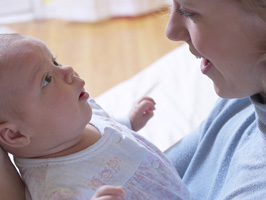Prepare a calm, quiet environment for conversation
- Make the human voice the sound he hears most often by minimising the sound of television and background noise coming from radios, computers and telephones.
Connect your baby with language by talking to him and listening to his response
- As you go about your daily tasks with your young baby talk clearly and directly to him about the things you are doing. This helps him to connect language with the experiences he is having every day. When he can see how you are moving your lips to make sounds and words it facilitates the work that is going on within him at this time to prepare his cheeks, lips, mouth, and throat to make the sounds he is hearing.
- Have conversations with your babbling baby by responding as if he is actually talking to you. When you listen and respond to his sounds, you are modelling having a conversation and this encourages him to keep practicing making sounds. If parents do not respond to babbling, babies gradually stop trying to communicate.
Find time to talk
- It does not take much effort to find the time to talk to your baby and listen to his response. You are with him for a large part of every day and you just need to describe the things that you are doing such as getting him dressed, preparing his food or going to the supermarket. You will find that when you factor this into your relationship with your child it does not really take any extra time just a little more effort.

